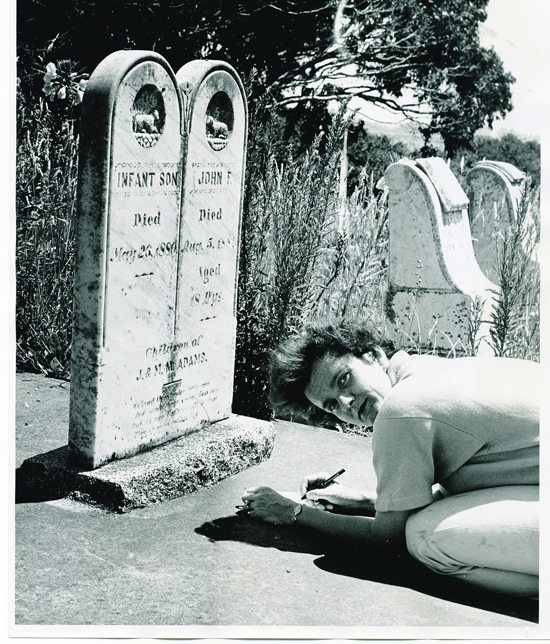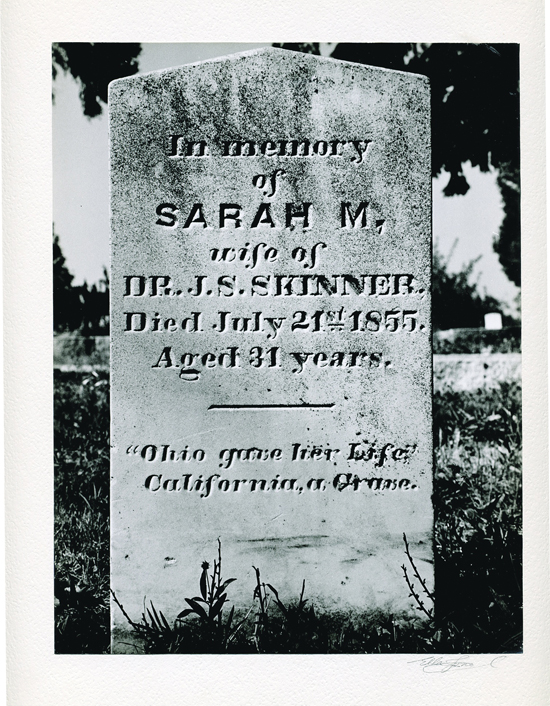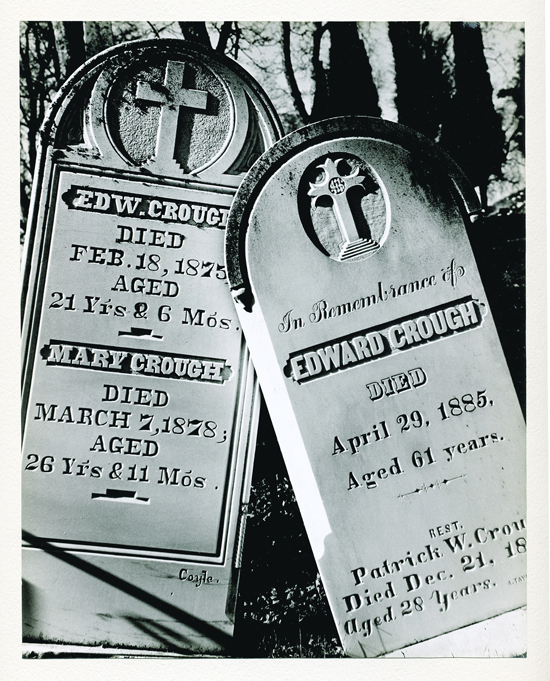| | Published August 14th, 2013
| An Afternoon with the Archivist
Traveling through the mists of time
| | By Laurie Snyder |  | | "God, how lucky can you be?" says Mary-Ellen Jones of her time as a noted historian and former archivist with The Bancroft Library. Jones is shown here early in her career, documenting tombstone carvings in Mendocino County, Calif. Photo Mary Ellen Maton
|
Those who would sooner poke their eyes out than peruse a history book might want to belay that thought and, instead, make the acquaintance of Mary-Ellen Jones. A resident of Orinda for nearly 50 years, she has a knack for making the study of history fun, and has dazzled everyone from famed documentarians to funeral directors.
 "I just don't ever remember not being interested in history. It probably stems from being born in Springfield," she shrugs. "Mother taught me to read at 4. So, I learned to read earlier than most kids. We always had books around the house, magazines. There was no shortage of stuff to read."
"I just don't ever remember not being interested in history. It probably stems from being born in Springfield," she shrugs. "Mother taught me to read at 4. So, I learned to read earlier than most kids. We always had books around the house, magazines. There was no shortage of stuff to read."
 Her beloved father also played a major role in fostering her passion for the past. A mechanical engineer who was forever schlepping visiting relatives around to historic sites, he often included his daughter in his adventures. On one of their outings, she ended up sitting on Abraham Lincoln's rocker.
Her beloved father also played a major role in fostering her passion for the past. A mechanical engineer who was forever schlepping visiting relatives around to historic sites, he often included his daughter in his adventures. On one of their outings, she ended up sitting on Abraham Lincoln's rocker.
 "It wasn't cordoned off the way it is now," she says with a bit of a laugh. "It was Lincoln's home the way he lived in it."
"It wasn't cordoned off the way it is now," she says with a bit of a laugh. "It was Lincoln's home the way he lived in it."
 After so many visits, her father had come to know the staff. "Apparently the custodian was bored that day, or maybe I asked a question. I must have said something that triggered it ... but [the custodian] picked me up and just plopped me there." Her Pop would later credit her becoming a history major at the University of California, Berkeley to that moment.
After so many visits, her father had come to know the staff. "Apparently the custodian was bored that day, or maybe I asked a question. I must have said something that triggered it ... but [the custodian] picked me up and just plopped me there." Her Pop would later credit her becoming a history major at the University of California, Berkeley to that moment.
 After graduation, she worked at the Sather Gate Book Store before accepting a position at Cal. "One of my jobs was to open the mail and separate it and put it on shelves to go to the branches. ... The books going to Bancroft Library I had to hand deliver." Bancroft's acquisitions librarian got to know her. A mentorship bloomed.
After graduation, she worked at the Sather Gate Book Store before accepting a position at Cal. "One of my jobs was to open the mail and separate it and put it on shelves to go to the branches. ... The books going to Bancroft Library I had to hand deliver." Bancroft's acquisitions librarian got to know her. A mentorship bloomed.
 Meanwhile, Jones became transfixed by tombstones. She began researching 19th century carvers, and started studying photography - first in Berkeley, then with Ansel Adams. She attended one of his Yosemite workshops, staying on for another 10 days to pick his brain.
Meanwhile, Jones became transfixed by tombstones. She began researching 19th century carvers, and started studying photography - first in Berkeley, then with Ansel Adams. She attended one of his Yosemite workshops, staying on for another 10 days to pick his brain.
 She also built her own darkroom, and was introduced by her Bancroft mentor to Professor George P. Hammond, the Coronado Expedition scholar and Bancroft director credited with making the library the powerhouse it is today. Jones and Hammond met and talked about photography, California history and tombstones. "Two weeks later I started work at Bancroft."
She also built her own darkroom, and was introduced by her Bancroft mentor to Professor George P. Hammond, the Coronado Expedition scholar and Bancroft director credited with making the library the powerhouse it is today. Jones and Hammond met and talked about photography, California history and tombstones. "Two weeks later I started work at Bancroft."
 Her first assignment was to read the 1870s-era works of the library's namesake, Hubert L. Bancroft. "Then, I was given the job of cataloging some material called, 'Bancroft's Dictations.'" Written in ink on letter-sized paper, these were handwritten interviews of the pioneer settlers still alive in Bancroft's day.
Her first assignment was to read the 1870s-era works of the library's namesake, Hubert L. Bancroft. "Then, I was given the job of cataloging some material called, 'Bancroft's Dictations.'" Written in ink on letter-sized paper, these were handwritten interviews of the pioneer settlers still alive in Bancroft's day.
 "The printed version doesn't do it," she says of the experience of holding history in one's hands. "I never got over the sheer joy of looking at original manuscripts."
"The printed version doesn't do it," she says of the experience of holding history in one's hands. "I never got over the sheer joy of looking at original manuscripts."
 About five years in, she organized the papers of Charles Fayette McGlasham, the newspaperman who wrote the first account of the Donner Party tragedy. Prior to his approach, no survivor had been willing to talk because of the cannibalism, says Jones. "He actually interviewed survivors. ... He got them to talk." His book, "History of the Donner Party," was very well received.
About five years in, she organized the papers of Charles Fayette McGlasham, the newspaperman who wrote the first account of the Donner Party tragedy. Prior to his approach, no survivor had been willing to talk because of the cannibalism, says Jones. "He actually interviewed survivors. ... He got them to talk." His book, "History of the Donner Party," was very well received.
 "The thing that really takes you to your knees is to look at the Breen Diary." Kept by Patrick Breen while he and his family were trapped in the Sierra, it conveys their ordeal in sparse, but riveting detail.
"The thing that really takes you to your knees is to look at the Breen Diary." Kept by Patrick Breen while he and his family were trapped in the Sierra, it conveys their ordeal in sparse, but riveting detail.
 Jones became a living authority on the Donner Party and, when it came time for PBS documentarians to retell the story, she was in the loop. Working as a consultant after retiring from The Bancroft, she was one of the few still trusted to handle McGlasham's collection and was recommended to filmmaker Ric Burns, brother of famed Civil War documentarian Ken Burns.
Jones became a living authority on the Donner Party and, when it came time for PBS documentarians to retell the story, she was in the loop. Working as a consultant after retiring from The Bancroft, she was one of the few still trusted to handle McGlasham's collection and was recommended to filmmaker Ric Burns, brother of famed Civil War documentarian Ken Burns.
 "He needed to see the Breen Diary," among other items. Using very small magnets, Jones carefully, temporarily affixed fragile materials from the collection on to a magnetic board, which was then seated on an easel for Burns to film. Afterward, he thanked Jones in the film's credits.
"He needed to see the Breen Diary," among other items. Using very small magnets, Jones carefully, temporarily affixed fragile materials from the collection on to a magnetic board, which was then seated on an easel for Burns to film. Afterward, he thanked Jones in the film's credits.
 Today, she keeps busy as the editor of the nationally respected magazine, "The California Historian," and still gives presentations to groups around the state. Her photos have also been exhibited at galleries across California.
Today, she keeps busy as the editor of the nationally respected magazine, "The California Historian," and still gives presentations to groups around the state. Her photos have also been exhibited at galleries across California.
 But her heart still clearly belongs to The Bancroft. Not long ago, while on her way home from an evening reception, she was struck once again by the building's beauty. Its lights burning brightly, the library was both a lantern illuminating the past - and a beacon beckoning future scholars and artists. "I was allowed to spend 50 years in that place," says Jones. "God, how lucky can you be?"
But her heart still clearly belongs to The Bancroft. Not long ago, while on her way home from an evening reception, she was struck once again by the building's beauty. Its lights burning brightly, the library was both a lantern illuminating the past - and a beacon beckoning future scholars and artists. "I was allowed to spend 50 years in that place," says Jones. "God, how lucky can you be?"

|
 | | Perhaps Dr. Skinner wished he'd never brought his wife out West? Tombstone inscriptions like this one at the Pine Grove Cemetery in Nevada City, Calif., often provide genealogists with new avenues for research. Photo Mary-Ellen Jones
|  | | "Those are blank pieces of marble coming out of the Columbia quarry," says tombstone expert Mary-Ellen Jones of the nearly 4-inch thick gravemarkers pictured here. Abnormally large, they are also unusual in that they were signed by their carvers. Jones believes that both were created by Hugh Coyle, her favorite artisan and that A. Taylor completed work on the stone at right, following Coyle's death.
| | | | | | | | | | | |
| | | print story
Before you print this article, please remember that it will remain in our archive for you to visit anytime.
download pdf
(use the pdf document for best printing results!) | | | Comments | | |
| | | | | | | | | | | | | | | | |




